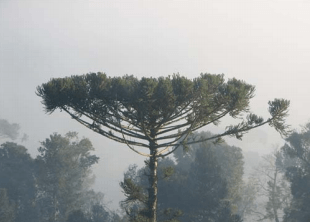
Center for Tropical Research October 2007 Newsletter
Feature Article
Alternative Mating Tactics in a Tropical Damselfly
by Brenda Larison, Senior Research Fellow, Center for Tropical Research, Institute of the Environment, UCLA
Field Report
Preserving Biodiversity in the Atlantic Forest of Brazil and its Araucaria Moist Forest Ecoregion
by Ana Paula Giorgi, Graduate Student, Department of Geography and Center for Tropical Research, Institute of the Environment, UCLA
Updates
CTR Director Tom Smith Appointed Acting Director of the UCLA Institute of the Environment
Tom Smith, Director of the Center for Tropical Research, has assumed additional responsibilities as the Acting Director of the UCLA Institute of the Environment. Mary Nichols, Director of the Institute of the Environment from 2004-2007, was named by Governor Arnold Schwarzenegger to head the California Air Resources Board. Tom Smith will continue to serve in both positions until a new permanent director for the Institute of the Environment is recruited.
John McCormack received his Ph.D. in Biology in September 2007 and is leaving UCLA to begin a postdoctoral research position at the University of Michigan in the lab of Dr. Lacey Knowles. His Ph.D. thesis was entitled, “Evolutionary Patterns and Processes at Multiple Spatial and Temporal Scales in a New World Jay.” At the University of Michigan, he will continue studying evolutionary processes in the “sky islands” of Arizona, Colorado, and Mexico.
CTR Welcomes New Postdoc and Graduate Students

Ryan Harrigan has joined CTR as a postdoctoral scholar working on the ecological correlates of infectious disease, including West Nile virus and avian influenza. This research will help to determine the role that vector ecology, climatic change, and host-vector dynamics play in the presence and prevalence of infectious diseases within particular environments, with a focus on the transmission of arboviruses within avian hosts (and secondary mammalian hosts, including humans) in North America. Ryan recently received his Ph.D. from Boston University, where his research focused on the phylogeography, population genetics, and hybridization of members of the Mallard complex (genus: Anas).
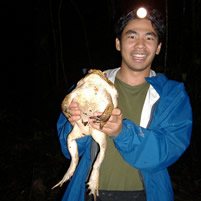
Hilton Oyamaguchi joined the research team at the Center for Tropical Research this Fall. He is a new graduate student from Brazil in the Department of Ecology and Evolutionary Biology. He completed his master’s thesis at the Universidade de São Paulo where he studied the spatial distribution of frogs in the Cerrado, the world’s most biologically rich savanna. His Ph.D. project will utilize frogs as a model to study diversification processes in the Amazonian rainforest.
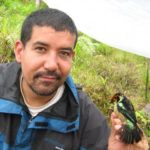
Raul Sedano, from Colombia, recently joined the Center for Tropical Research. He received his master’s degree from San Diego State University, where he was studying the phylogeny and biogeography of mountain tanagers. His Ph.D. research project in the Department of Ecology and Evolutionary Biology at UCLA will focus on Neotropical birds in northwestern South America.
Field Research Trips
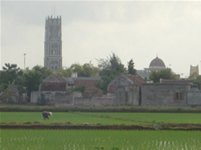
Tom Dietsch traveled to Vietnam in July for a pre-research planning trip for a new project that will monitor wild birds for avian inflenza in the Red River delta region. The project, entitled “Evaluating disease transmission pathways and host reservoirs for H5N1 avian influenza in domestic and wild bird communities of Viet Nam,” will assess the subtypes and strains of avian influenza across a gradient of human land-use from home gardens to natural wetlands in coastal communities of northern Vietnam. This research was made possible through support provided by the Office of Health, Infectious Disease and Nutrition, the Bureau for Global Health, the U.S. Agency for International Development, and the Wildlife Conservation Society.
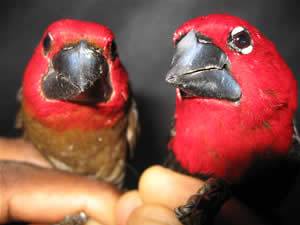
Tom Smith conducted a month of field research in Cameroon this summer collecting samples for avian blood parasite studies. In addition, he conducted research on Black-bellied Seedcrackers (Pyrenestes ostrinus,pictured above) a species of African finch that shows a polymorphism in bill size. Smith began working on seedcrackers in 1983 as part of his Ph.D. dissertation. On this trip he returned to the village of Ndibi, in south central Cameroon, where he has been working for over 20 years. The work is part of a new collaborative study with Dr. Arkhat Abzhanov, from Harvard University, and is aimed at identifying the genes determining bill size in this finch.
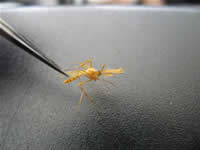
Kevin Njabo sampled mosquitoes in twelve localities in lowland forest areas in Cameroon from June 15 to September 15 using CO2-baited CDC light and gravid traps. Over 6,000 culicine mosquitoes from 13 genera were collected from these sites, including Coquillettidia mosquitoes, which had never before been reported in this area. These results highlight the diversity of vectors and the possibility of defining new potential vectors, regional differences in vector competence, and the need to conduct further studies to develop effective programs for mosquito control.
Awards, Presentations, and Appointments
Tom Dietsch presented at two meetings in August 2007. He gave a talk on “Avian influenza and wild birds” to the New World Agriculture and Ecology International Meeting in Santa Cruz, California and gave two presentations at the Ecology Society of America annual meeting in San Jose, California. He spoke on “Evaluating birds and shade tree communities in cacao agricultural landscapes of Cameroon” at the Organized Oral Session on Ecoagriculture: Restoring wild biodiversity, livelihoods, and ecosytem processes in agricultural landscapes and was co-author for a talk on “Landscape constraints on functional diversity in tropical agroecosystems” at the Organized Oral Session on Tropical agroforestry as model systems for ecology.
Allison Alvarado received a conference travel grant from the Department of Ecology and Evolutionary Biology to attend the Cooper Ornithological Society Annual Meeting held in Moscow, Idaho in June 2007.
Jaime Chaves received a Lida Scott Brown Fellowship for Fall 2007 and a Lida Scott Brown Research Award for the 2007-2008 academic year. He also received a conference travel grant from the Department of Ecology and Evolutionary Biology to attend the VIII Neotropical Ornithological Congress in Maturín, Venezuela, May 13 to 19, 2007, where he gave an oral presentation.
Amy Rogers received a Department of Ecology and Evolutionary Biology Dissertation Year Fellowship for 2006-2007.
Ben Wang received a Department of Ecology and Evolutionary Biology Dissertation Completion Fellowship for Summer 2007.
Grants
- Disney Wildlife Conservation Fund
Hornbill Conservation in Cameroon Cocoa. (2007-2008) - Disney Wildlife Conservation Fund
Umbrellabird Conservation in the Chocó. (2007-2008) - Wildlife Conservation Society
Evaluating Disease Transmission Pathways and Host Reservoirs for H5N1 Avian Influenza in Domestic and Wild Bird Communities of Viet Nam. (2007-2008)
Donors
CTR would like to thank Margery Nicolson for her generous on-going financial support for a number of CTR research projects. CTR would also like to thank Gary Morris and the GAIA Foundation for its support for CTR’s International Research and Training Center in Ecuador. In addition, we would like to thank the Sea & Sage Audubon and Pomona Valley Audubon Society chapters for their financial support for CTR’s research project studying the genetics of the Southern California population of Tricolored Blackbirds.
